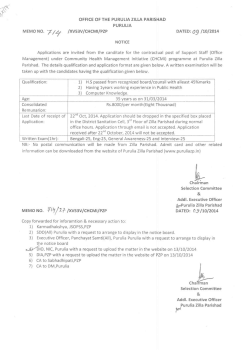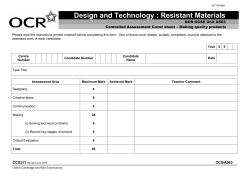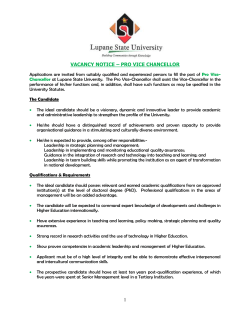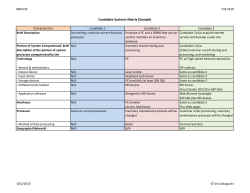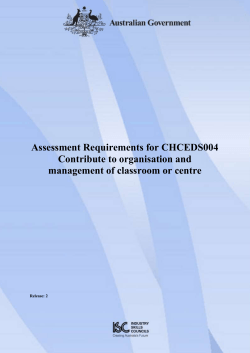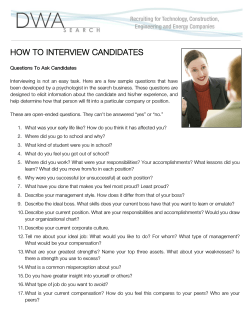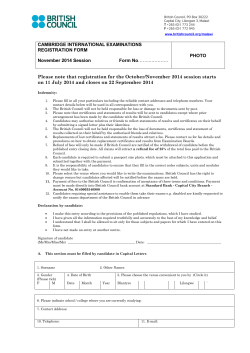
OCR Nationals
Unit Title: Interpersonal and Written Communication OCR unit number 196 Level: 2 Credit value: 9 Guided learning hours: 60 Unit reference number: T/500/7207 Candidates undertaking this unit must complete real work activities in a work environment. Simulation is only allowed in exceptional circumstances (please refer to the centre handbook for further details). Unit purpose and aim This is the ability to communicate using language and terminology that is appropriate to the audience. This will involve sending and receiving familiar information by communicating interpersonally and writing in familiar situations. Learning Outcomes Assessment Criteria The Learner will: 1 Send and receive familiar information by communicating interpersonally in familiar situations The Learner can: 1.1 Apply knowledge of the following interpersonal communication techniques: verbal (eg intonation, tone and feedback (sometimes referred to as verbal attends) and nonverbal techniques (eg smiling while talking on the phone, body language). attentive listening (i.e. difference between hearing and listening). positive and negative language. active listening (eg summarising, paraphrasing, body language); listening barriers (eg background noise, distractions, lack of concentration); types of question (eg open, closed and probing). 1.2 Use the following interpersonal communication techniques: modulating voice when speaking to suit the listener or audience © OCR 2013 Knowledge, understanding and skills Candidates must have an understanding of the different skills associated with interpersonal and written communication to include: verbal communication skills, including tone, positive and negative language listening skills and techniques barriers to listening questioning techniques 1 Learning Outcomes Assessment Criteria Knowledge, understanding and skills articulating and expressing ideas clearly and concisely listening actively (eg by taking notes) clarifying and confirming understanding (eg by paraphrasing or repetition). responding to questions with accurate information ensuring content is appropriate to the needs of the audience identifying and avoiding listening barriers maintaining focus on the purpose of the communication 2 2 Communicate in writing in familiar situations 2.1 Apply knowledge of the following written communication techniques: Grammar, spelling. 2.2 Use the following techniques to produce and interpret written communication following organisational guidelines and procedures; identifying and conveying key messages in writing (eg letter, fax, email, database notes); using correct grammar and spelling. using and understanding appropriate business or technical terminology; ensuring content, format and style are appropriate to the audience and channel (eg letter, memo, fax, e-mail, web chat); structuring writing into a logical framework; conveying ideas and information in a clear and concise manner; identifying relevant information in written communications; reviewing or proof reading own written work. Candidates must have an understanding of written communication techniques to include: accurate spelling and grammar and use of proof reading organisational procedures and guidelines for written communication use of correct format depending on method of communication meeting the needs of the intended audience to include, content, style, terminology, use of jargon identifying relevant information from written documents © OCR 2013 Assessment Candidates undertaking this unit must complete real work activities in order to produce evidence to demonstrate they are occupationally competent. Real work is where the candidate is engaged in activities that contribute to the aims of the organisation by whom they are employed, for example in paid employment or working in a voluntary capacity. Simulation is only allowed for aspects of units when a candidate is required to complete a work activity that does not occur on a regular basis and therefore opportunities to complete a particular work activity do not easily arise. When simulation is used, assessors must be confident that the simulation replicates the workplace to such an extent that candidates will be able to fully transfer their occupational competence to the workplace and real situations. Internal quality assurance personnel must agree the use of simulated activities before they take place and must sample all evidence produced through simulated activities. It is the assessor’s role to satisfy themselves that evidence is available for all performance, knowledge and evidence requirements before they can decide that a candidate has finished a unit. Where performance and knowledge requirements allow evidence to be generated by other methods, for example by questioning the candidate, assessors must be satisfied that the candidate will be competent under these conditions or in these types of situations in the workplace in the future. Evidence of questions must include a written account of the question and the candidate’s response. Observations and/or witness testimonies must be detailed and put the evidence into context ie the purpose of the work etc. All of the assessment criteria in the unit must be achieved and clearly evidenced in the submitted work, which is externally assessed by OCR. Evidence for the knowledge must be explicitly presented and not implied through other forms of evidence. Evidence requirements All aspects of the assessment criteria must be covered and evidence must be available that shows where and how the assessment criteria have been achieved. Assessment Criterion 1 Candidates must provide evidence of applying a range of interpersonal communication techniques in familiar situations. The main source of evidence will be a detailed observation or witness testimony, explaining the purpose of the communication and how the candidate met each of the assessment criteria. Assessment Criterion 2 Candidates must provide documentary evidence of written communication ensuring that all assessment criteria have been met. Written communication MUST BE accurate with respect to spelling and grammar. The purpose of each written communication must be made clear ie who the intended audience is, is it to provide information, obtain information etc. Candidates are encouraged to choose activities which will allow them to cover all or a majority of the criteria at one time. It is not necessary to use different activities for each element of the criterion. © OCR 2013 3 Guidance on assessment and evidence requirements Evidence can reflect how the candidate carried out the process or it can be the product of a candidate’s work or a product relating to the candidate’s competence. For example: The process that the candidate carries out could be recorded in a detailed personal statement or witness testimony. It is the assessor’s responsibility to make sure that the evidence a candidate submits for assessment meets the requirements of the unit. Questioning the candidate is normally an ongoing part of the assessment process, and is necessary to: test a candidate’s knowledge of facts and procedures check if a candidate understands principles and theories and collect information on the type and purpose of the processes a candidate has gone through. candidate responses must be recorded It is difficult to give a detailed answer to how much evidence is required as it depends on the type of evidence collected and the judgement of assessors. The main principles, however, are as follows: for a candidate to be judged competent in a unit, the evidence presented must satisfy: all the items listed, in the section ‘Learning Outcomes’ all the areas in the section ‘Assessment Criteria’ The quality and breadth of evidence provided should determine whether an assessor is confident that a candidate is competent or not. Assessors must be convinced that candidates working on their own can work independently to the required standard. Additional information For further information regarding administration for this qualification, please refer to the OCR document ‘Admin Guide: Vocational Qualifications’ (A850) on the OCR website www.ocr.org.uk . 4 © OCR 2013
© Copyright 2025

